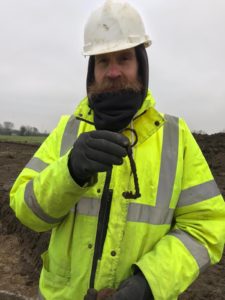Archaeology tour guides share their experiences
By Caroline Prance and John Scarborough, Earth Trust volunteers
As we share more of our archaeological finds from the dig, this week we’ve also caught up with two of our volunteer tour guides. Here they share what inspired them to take part, and some of their highlights from the last few months.
Personal highlights
Caroline: Having relocated to Oxfordshire two years ago, the chance to be involved with Earth Trust and be part of the guided tours of the Clumps and dig site was too good an opportunity to miss. And what an experience! Visiting the Clumps on a regular basis we witnessed their splendour in all weathers. From the freezing cold (how many layers is it possible to put on?) driving rain (will my jacket and boots really keep me dry?) the blustery winds (did anyone else hear that before the wind blew the words away?) to the beautiful sunny days (anyone got a spare pair of sunglasses?) of early spring. Every visit brought with it something different and something not seen before. We even watched as Didcot Power Station emerged out of the mist the week before it was demolished and the landscape changed for ever.
John: One aspect of the tours that I really enjoyed was talking about the commanding location of the Clumps. The two wings of the Ridgeway disappear into the distance towards Avebury in the south west and Ivinghoe Beacon in the north east. The nearby Roman road heads north from Silchester (towards the Clumps), and then follows the Thames round Streatley, Cholsey and Brightwell Cum Sotwell before heading over the Sinodun hills.
Tales from the tours
Stories were told of the disorganised Iron Age folk. Rumour has it, they removed clothing and donned armours of blue ‘paint’ (a mixture of crushed woad, a plant used for blue dye, and urine) and stood on top of Castle Hill waiting for the more organised Roman military. We also shared tales of war artist Paul Nash, who was enchanted by the shapes and mystique of the Clumps. And last but not least, of the Poem Tree and the local ‘naughty lad’ Joseph Tubb who dreamt of becoming a wood carver, and snuck off to carve out his poem on a tree.
Learning from DigVentures

DigVentures holding the 2,000 year old key
There was always a sense of expectation when we approached the archaeologists in the trenches because we could see how the dig had progressed each week. DigVentures, digging away in all weathers, were always smiling and keen to make archaeology come alive.
Caroline: An abiding memory for me was hearing about skeletons found before going to the site. Despite the warnings, I wasn’t prepared for my first viewing of a skeleton being gently revealed and the emotions this would evoke in me.
John: One find that had “wow” factor for me was the key! It had, amazingly, survived despite being so close to the surface – but what did it lock? It was very well made and one would assume from the shank length that the door (or box) was quite thick and robust.
A lasting impression
Above all, the greatest privilege was to meet so many people on the tours who were so generous in sharing their stories and knowledge – we learnt something new on every tour. Our understanding of the area improved tenfold, enriched by those personal accounts. Childhood memories of playing on the Clumps, flying kites, running, remembering the Poem Tree, and sharing the work of Nash and other local artists, as well as knowledge of the local archaeology.
Caroline adds: We were also able to meet another volunteer Chris, who was due to lead tours but very sadly died unexpectedly. I joined Chris on one of his practice runs of the tour, and remember his huge knowledge base, his humbleness and infectious sense of fun – an unforgettable character.